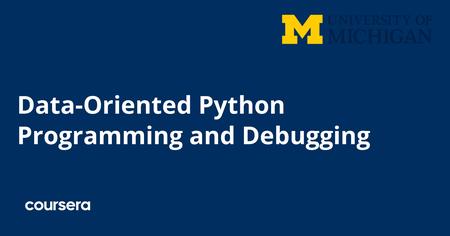English | MP4 | AVC 1280×720 | AAC 44KHz 2ch | 147 Lessons (18h 20m) | 6.92 GB
Write and systematically debug Python code. . Learn to develop readable and reproducible code in Python while investigating, manipulating, and analyzing real-world data using Python libraries.
What you’ll learn
- Effective use of modules, functions, and object methods in data-driven computing.
- Competent independent debugging and self-help skills in Python.
- Proficient programming with common data structures such as arrays and DataFrames using libraries like NumPy and pandas.
Skills you’ll gain
- Statistics
- Python (Programming Language)
- SciPy
- Debugging
- NumPy
- Data Analysis
- Critical Thinking
- Pandas (Python Package)
- Data Manipulation
In “Data-Oriented Python Programming and Debugging,” you will develop Python debugging skills and learn best practices, helping you become a better data-oriented programmer. Courses in the series will explore how to write and debug code, as well as manipulate and analyze data using Python’s NumPy, pandas, and SciPy libraries. You’ll rely on the OILER framework – Orient, Investigate, Locate, Experiment, and Reflect – to systematically approach debugging and ensure your code is readable and reproducible, ensuring you produce high-quality code in all of your projects. The series concludes with a capstone project, where you’ll use these skills to debug and analyze a real-world data set, showcasing your skills in data manipulation, statistical analysis, and scientific computing.
Applied Learning Project
Perform Python debugging assignments on real data sets using Jupyter notebooks. Build your skills through debugging challenges and practice labs, using data sets from sports, weather, movies, and more. Complete a capstone project showcasing your skills as a data-oriented debugger using a transportation data set.
Table of Contents
numpy-and-pandas-basics-for-future-data-scientists
introduction-to-numpy-arrays-and-basic-operations
welcome-to-the-course
1 welcome-to-the-specialization
2 course-syllabus_instructions
3 help-us-learn-about-you_instructions
introduction-to-numpy-arrays-and-basic-operations
4 welcome-to-course-2
5 meet-the-numpy-array
6 creating-a-numpy-array
7 array-attributes
8 accessing-and-slicing-arrays
9 handling-missing-data
10 basic-array-operations
11 numpy-tutorial_instructions
12 debugging-demo
advanced-numpy-array-manipulations-and-operations
advanced-numpy-array-manipulations-and-operations
13 aggregating-functions
14 broadcasting
15 reshaping-arrays
16 sorting-arrays
17 joining-arrays
18 getting-started-with-pandas_index
19 getting-started-with-pandas_instructions
20 debugging-challenge
mastering-pandas-for-data-science
mastering-pandas-for-data-science
21 series-and-dataframes
22 reading-and-inspecting-dataframes
23 manipulating-dataframes-intro-to-map-and-apply
24 filtering-dataframes
25 handling-missing-data
26 debugging-challenge
advanced-data-handling-and-analysis-with-pandas
advanced-data-handling-and-analysis-with-pandas
27 concatenating-dataframes
28 merging-joining-dataframes
29 reshaping-dataframes
30 aggregation
31 filtration
32 transformation
33 apply
34 debugging-challenge-video
35 post-course-survey_instructions
36 attributions_instructions
Resources
jupyter-notebook-faq
37 resources
python-debugging-a-systematic-approach
review-and-setup
welcome
38 welcome-to-the-course-and-specialization
39 course-syllabus_instructions
40 help-us-learn-about-you_instructions
review-and-setup
41 welcome-to-course-1
42 intro-to-jupyter-notebook
43 course-content-disclaimers_instructions
44 recommender-systems_instructions
45 review-map-filter-list-comprehensions
the-debugging-framework
the-debugging-framework
46 overview-of-the-debugging-framework
47 orient-yourself
48 investigate-the-symptoms-part-i-understanding-error-messages
49 investigate-the-symptoms-part-ii-code-vs-intention-mismatch
50 investigate-the-symptoms-part-iii-misunderstanding-computations-and-data
51 locate-the-root-cause
52 experiment-with-a-fix
53 reflect
54 oiler-framework-part-1-chapters-1-6_instructions
framework-skills
framework-skills
55 framework-example-2
56 framework-example-3
57 oiler-framework-part-2-chapters-7-12_instructions
58 debugging-with-an-llm
59 debugging-with-the-internet
60 debugging-with-docs
61 using-the-jupyter-debugger
stop-bugs-before-they-happen
stop-bugs-before-they-happen
62 introduction-make-it-easy-on-future-you
63 dry-don-t-repeat-yourself-part-1-iterate
64 dry-don-t-repeat-yourself-part-2-write-a-function
65 documenting-functions
66 making-your-notebook-reproducible
67 ten-simple-rules-for-writing-and-sharing-computational-analyses-in-jupyter_instructions
68 post-course-survey_instructions
69 attributions_instructions
Resources
jupyter-notebook-faq
70 resources
python-debugging-capstone-project-fixing-and-extending-code
project-briefing
welcome-to-the-course
71 welcome-to-the-course-and-specialization
72 course-syllabus_instructions
73 help-us-learn-about-you_instructions
project-briefing
74 welcome-to-course-4
75 your-briefing
76 railroad-data-collection-methodology-report_instructions
77 pandas-review_index
78 pandas-review_instructions
79 numpy-review_instructions
80 review-of-framework_instructions
81 structuring-data-science-projects_instructions
82 why-does-project-structure-matter_instructions
updated-requirements-and-final-deliverable
updated-requirements-and-final-deliverable
83 new-briefing
84 documenting-your-work_instructions
85 outro-for-series
86 post-course-survey_instructions
87 attributions_instructions
Resources
jupyter-notebook-faq
88 resources
statistics-with-python-using-numpy-pandas-and-scipy
vector-operations-and-text-representation-in-data-science
welcome-to-the-course
89 welcome-to-the-course-and-specialization
90 course-syllabus_instructions
91 help-us-learn-about-you_instructions
vector-operations-and-text-representation-in-data-science
92 welcome-to-course-3
93 vector-dot-products-code
94 text-as-vectors-code
95 matrix-multiplication
96 debugging-challenge
understanding-and-visualizing-data-distributions
understanding-and-analyzing-data-distribution-characteristics
97 basic-probability-with-a-bernoulli
98 discrete-data-distributions
99 continuous-data-distributions
100 debugging-challenge
understanding-and-analyzing-data-distribution-characteristics
understanding-and-analyzing-data-distribution-characteristics
101 learning-from-data-distributions
102 reasoning-about-probability-from-a-distribution
103 special-properties-of-normal-distributions
104 linear-relationships-in-data
105 probability-and-uncertainty
106 debugging-challenge
sampling-methods-and-statistical-inference
sampling-methods-and-statistical-inference
107 sampling-distributions
108 how-sample-size-affects-variance-of-the-sampling-distribution
109 bootstrap-sampling
110 the-central-limit-theorem
111 statistical-inference-part-1-null-hypothesis-testing
112 statistical-inference-part-2-simulating-the-null-with-shuffling
113 statistical-inference-part-3-bootstrap-confidence-intervals
114 statistical-inference-part-4-a-bayesian-approach
115 debugging-challenge
116 post-course-survey_instructions
117 attributions_instructions
Resources
jupyter-notebook-faq
118 resources
Resolve the captcha to access the links!
